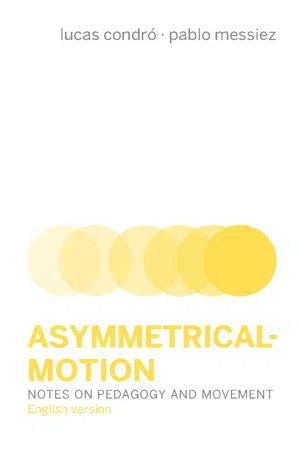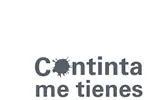
eBook - ePub
Asymmetrical-Motion
Notes on pedagogy and movement
Lucas Condró, Pablo Messiez, Carlota Gaviño
This is a test
Compartir libro
- 88 páginas
- English
- ePUB (apto para móviles)
- Disponible en iOS y Android
eBook - ePub
Asymmetrical-Motion
Notes on pedagogy and movement
Lucas Condró, Pablo Messiez, Carlota Gaviño
Detalles del libro
Vista previa del libro
Índice
Citas
Información del libro
Lucas Condró and Pablo Messiez gather in this essay a set of notes on pedagogy and movement, result from their long experience giving workshops on the work with the body.English version byCarlota Gaviño.
Preguntas frecuentes
¿Cómo cancelo mi suscripción?
¿Cómo descargo los libros?
Por el momento, todos nuestros libros ePub adaptables a dispositivos móviles se pueden descargar a través de la aplicación. La mayor parte de nuestros PDF también se puede descargar y ya estamos trabajando para que el resto también sea descargable. Obtén más información aquí.
¿En qué se diferencian los planes de precios?
Ambos planes te permiten acceder por completo a la biblioteca y a todas las funciones de Perlego. Las únicas diferencias son el precio y el período de suscripción: con el plan anual ahorrarás en torno a un 30 % en comparación con 12 meses de un plan mensual.
¿Qué es Perlego?
Somos un servicio de suscripción de libros de texto en línea que te permite acceder a toda una biblioteca en línea por menos de lo que cuesta un libro al mes. Con más de un millón de libros sobre más de 1000 categorías, ¡tenemos todo lo que necesitas! Obtén más información aquí.
¿Perlego ofrece la función de texto a voz?
Busca el símbolo de lectura en voz alta en tu próximo libro para ver si puedes escucharlo. La herramienta de lectura en voz alta lee el texto en voz alta por ti, resaltando el texto a medida que se lee. Puedes pausarla, acelerarla y ralentizarla. Obtén más información aquí.
¿Es Asymmetrical-Motion un PDF/ePUB en línea?
Sí, puedes acceder a Asymmetrical-Motion de Lucas Condró, Pablo Messiez, Carlota Gaviño en formato PDF o ePUB, así como a otros libros populares de Media & Performing Arts y Performing Arts. Tenemos más de un millón de libros disponibles en nuestro catálogo para que explores.
Información
Categoría
Media & Performing ArtsCategoría
Performing ArtsNOTES ON PEDAGOGY AND MOVEMENT

Continta Me Tienes
C/ Belmonte de Tajo 55, 3º C
28019, Madrid
91 469 35 12
www.contintametienes.com
www.facebook.com/ContintaMeTienes
@Continta_mt
Escénicas collection, 12
First edition: February, 2016
Second edition: May, 2016
© Lucas Condró y Pablo Messiez
© of traduction: Carlota Gaviño
© of this edition: Continta Me Tienes
Cover design: Marta Azparren
Lucas Condró & Pablo Messiez
NOTES ON PEDAGOGY AND MOVEMENT
English version

Index
Introduction
Notes
Exercises
Introduction
Asymmetrical-Motion is a research on movement in the field of contemporary dance.
I have long been interested in two main ideas. On the one hand, the logic ruling independence and correlation of the parts of the body: the possibility of moving each one trying to understand its uniqueness, and then that of moving all of them at the same time while preserving the independence of each one. On the other hand, the ideas of structure and weight as two factors that simultaneously provide the body with movement and agility.
These two ideas revealed to me the asymmetries of the body appearing in movement, something which was already inherent in the nature of the body and which, however, the habits of training had kept silent. Then, I decided that the name of the research was to be Asymmetrical-Motion. Giving a name to the work inevitably changes the scope. It leads the eyes towards some areas, discarding others. It focuses the work and sharpens it.
At the same time, I felt the need to think about the pedagogical questions that had developed in parallel with my practice. What was their specificity, if any? And then appeared the idea of observing to be able to understand; naming that which had been observed to be able to transform the experience into tools; and then taking those tools back to the body.
The possibility of creating together a single common body appeared as well. The aim of generating a certain work logic from a shared object of study. Each one’s reflections will be the tools that allow the construction of that joint knowledge, of that single shared body.
However, if generating a single body is the aim, attention should be focused on neither the teacher, nor the students, but rather on that other body resulting from ...